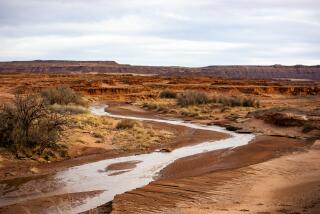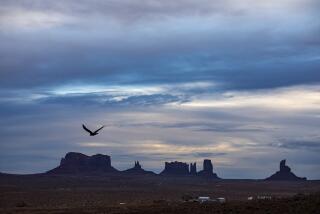Tapping Into the Biggest Extravagance in Vegas
- Share via
Not surprisingly, this special Vegas Issue is laced with examples of hedonism and tackiness: the $2,000 martini, complete with bejeweled swizzle stick, at the Hard Rock Hotel & Casino; the
$15,000-a-night stay at the MGM Grand; the forested mountain that has risen up not from the hand of God but, rather, from the wallet of Steve Wynn.
Yet of all the extravagances in Sin City, one surely tops the rest: water.
The desert metropolis, remember, typically gets a mere 4 inches of rainfall annually. Los Angeles, with about 15 inches, is a veritable Amazon by comparison.
Despite Vegas’ aridity, things looked for a while as if they were going--please pardon the expression--swimmingly. Smart and aggressive, the Southern Nevada Water Authority had executed a series of deals to maximize the fast-growing region’s draw from the Colorado River.
Until about 2000, “I would have told you that we had pieced enough solutions together that we were going to be in good shape for the next 40 to 50 years,” says Pat Mulroy, the water authority’s general manager.
But then drought struck. So Mulroy and her troops asked folks to abide by something that one doesn’t normally associate with their town: They called for parsimony, at least regarding the tap. Actually, they didn’t just ask. They insisted.
Under the rules, newly built homes can have no lawn in the front, and only 50% of the back can be grass. (Similar restrictions apply to multifamily dwellings and businesses.) Golf courses have been put on a serious water diet. And all waste water in the area is now recycled; what’s flushed in Vegas stays in Vegas.
Meantime, residents must run their sprinklers on a limited schedule--or face penalties. People “love to squeal on their neighbors,” Mulroy says.
They can also cash in. Mulroy’s agency pays $1 a square foot to those who pull out their turf and replace it with so-called water-smart landscaping. So far, some 75 million square feet of lawn has been yanked--saving enough water to meet the needs of 76,500 households for a year.
“We really set out to change the culture of this community,” Mulroy says, noting that southern Nevada is actually using less water than it did a couple of years ago despite 8,000 people a month moving in.
Some remain anxious nonetheless. Farrel Lytle, whose family has been ranching since the 1800s in Eagle Valley, about 200 miles north of Vegas, figures it’s almost inevitable that his part of the state will be sucked dry, its way of life altered forever. Conservation or not, he points out, Mulroy’s outfit has already made plans to sink wells in his county and one farther north, and then pipe the water southward to meet the relentless demand.
“It’s exactly what Los Angeles did along the Owens River,” Lytle says. (See Rearview Mirror, page 8.) Sadly, it’s a scenario you can bet on.
More to Read
Sign up for Essential California
The most important California stories and recommendations in your inbox every morning.
You may occasionally receive promotional content from the Los Angeles Times.













